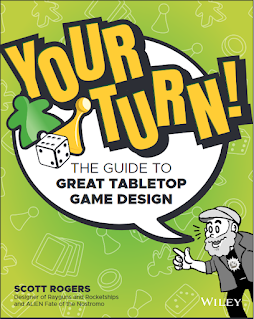Happy Day After Halloween!
One of my talks in my level design class is about making scary level design - the same lessons I learned from making physical haunted houses. I thought I'd share these lessons with you for your own scary levels (and haunts)!
1. Set up the scary - the line in is just as important as the haunted house. If you build a scary environment that leads up to the haunted house, you are giving the player the message that this location will be scary. Use lighting, sound and very simple atmospheric effects to build tension. Make sure the player sees the weenie of the Haunted House, so they always know where they are headed - into danger.
2. Empty rooms build tension - Haunted Houses are like roller coasters - you need to go up before you drop down. Not every room needs a scare, put a room or two between each scare to really ratchet things up. Alternate between big and small rooms to create changes in mood - tight, narrow rooms and hallways create mystery and tension, big rooms create relief, but can also cause unease due to scale. The scariest room I ever went through in a haunted house was a closet filled with hanging clothing. There were no scares, but because I had to push through the clothes and into the darkness to get through, it was terrifying - creating an environment that preyed on childhood fears.
3. Create unease with lighting - Many games forget to use basic lighting stage effects like gobos and cookies to create interesting patterns and textures. These lighting effects can be very effective to create mood. Strobes are also good but use them too much and you'll make people dizzy
4. Shadows make monsters scarier - The best monsters are the ones you can't quite see. Think about how little of the beast you saw in the movie "Alien" - that's what made it scary. However, you want to be careful with pitch darkness because that causes people to stop. You want to keep them moving by giving them something to move towards however if you want a monster to jump out of the dark, precede it with light so the darkness seems darker when they get to it
5. Use all available sense - There are two types of scary environments: Terror and Horror. Terror works on fear - fear of the unknown, of darkness of mystery. Horror works on revulsion - fear of death, fear of body, fear of filth. Terror is easy to do with lighting, sound and sight, however horror - gross things - requires touch and smell - trickier to do and not often done. In a physical haunted house, you can try simple things like alternating the textures of the surfaces on the floor or the hanging partitions (I recently went through a haunted house where the "drapes" that you passed through to get into a slaughterhouse felt like rough leather or beef jerky - it was very effective in giving the room some "feeling") - maybe once haptic controls become common, horror will be more effective.
6. Don't overdo the gross - this is my personal opinion, but too much guts and blood becomes numbing. In video games, we don't have the two senses - smell and touch - available that makes horror gross. After a while all those severed hanging torsos start to look like macabre Christmas decorations. To have a greater effect, use gore sparingly.
7. Corners are the scariest places - Corners not only obscure vision but hide things. It's a spot where the player will slow down, but you will also build the tension. It's even better if you can have a sound or a shadow cast on the wall to let the player know their worst fears are confirmed and there IS something lurking around the corner.
8. Let them know it's coming - jump scares are fine, but they tend to wear down victims... er players. I find it's just as scary to have something sitting in the middle of the room that the player thinks might do something, but they are not quite sure if it will or not. These are things like beds or chairs with figures sitting in them. The player knows the character is going to sprung up and the tension of having to pass by or move around it can create an excellent scare. Even better, in video games we can use alternate cameras to show what is coming from behind them or we can use alternate viewing interfaces like motion detectors (like in Alien: Isolation) or special senses (like in the Last of Us) to show us that the baddie is almost on top of us.
Some essential games to play: Dead Space 1 and 2, Resident Evil 2, The Last of Us, The original Alone in the Dark, Fatal Frame II: Crimson Butterfly, Silent Hill, Haunting Ground, Luigi's Mansion

















No comments:
Post a Comment